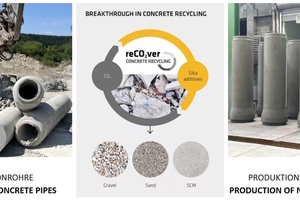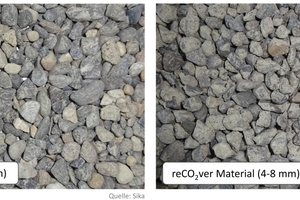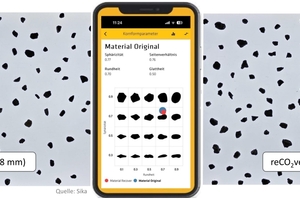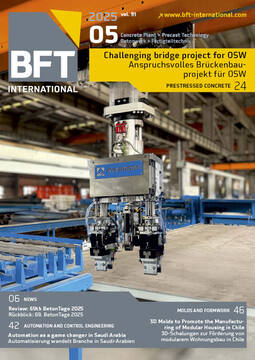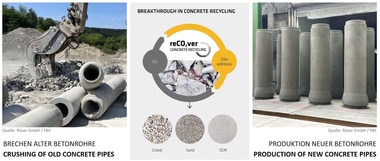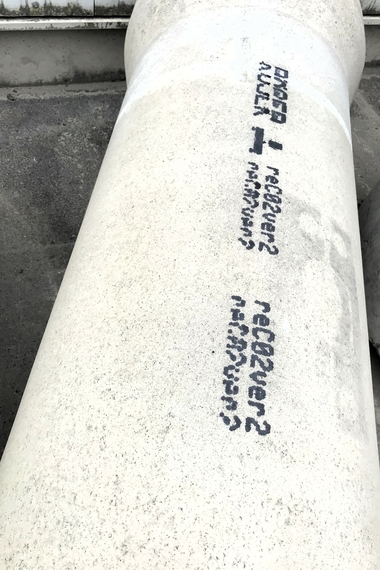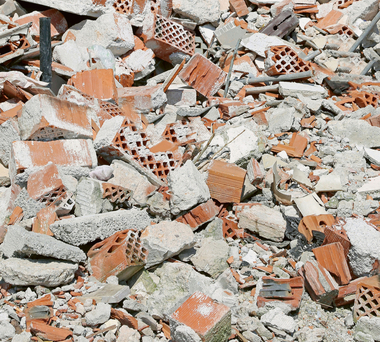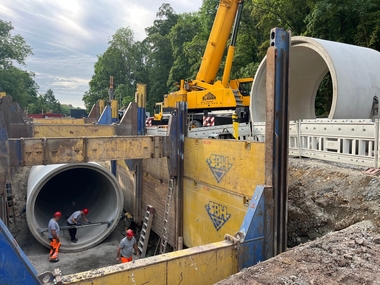Circular economy for concrete pipes:
New pipes made of old pipes
Concrete and reinforced-concrete pipes can already be used as a source of recycled aggregate. However, a true circular economy would require the use of the highest possible proportion of recycled concrete rubble in pipe production. Here we present a pilot project. The article focuses on the problem and the findings obtained in laboratory tests.
Introduction
The sewer system is one of the most important elements of our built environment. It is the backbone of our health and contributes significantly to the performance of society. This is where the megatrends of urbanization and environmental protection give rise to major challenges. On the one hand, the sewer system must be durable to reliably fulfill its function. On the other hand, the building materials used must be recyclable to enable possible adaptation to population growth in a resource-saving manner.
Challenges of recycling concrete rubble
Concrete and reinforced-concrete pipes are made of mineral construction materials and can be fully reused as recycled aggregates. However, the goal of achieving the highest possible proportion of recycled concrete rubble in pipe production has so far been limited not only by regulatory requirements but also by technological constraints such as the high and variable water absorption and the large and rough surface of the concrete rubble. Either of these factors has a negative impact on the production and quality of concrete pipes in the production process with immediate demolding.
Processing with reCO2ver
With the reCO2ver process, Sika has developed a processing technology that results in recycled aggregate with an almost primary sand and gravel quality. This process takes place in several steps. In the first step, the old concrete pre-crushed to a standard but unscreened recycling grain size is subjected to intense frictional forces in a specially designed ball mill in a continuous process. This leads to the grinding of the hardened cement paste and cleaning of the surfaces of gravel, grit and sand grains (more detail is provided in the video at https://fbs-beton.de/recycling/). The “cleaned” material is then separated into the various fractions on a screening system. The cement paste, ground into powder, leaves the mill with the air and is separated by a filter system. If desired, in a separate second step, the powder can be carbonated with CO2 in batches in a special reactor. The amount of CO2 bound in this process, approximately 50-60 kg per ton of powder, is measurable and can thus be certified.
Laboratory tests to determine the concrete design
As part of a pilot project with the Federal Association of Concrete Sewer Systems (FBS) and Röser Group, pre-crushed concrete pipes were treated using Sika’s reCO2ver process at the pilot plant in Weiach, Switzerland, to produce new pipes with the recovered materials at the Röser II site in Krauchenwies. Since there was no experience with the industrial application of reCO2ver material in semi-dry concrete at that time, the concrete was designed and assessed for its production and quality characteristics in laboratory tests. The following steps were carried out in Sika’s special laboratory for semi-dry concrete technology in Leimen:
1. Characterization of the aggregates,
2. Development of the concrete design,
3. Comparison of fresh and hardened concrete data.
In the first step, both the original material and the reCO2ver material were examined for density, water absorption, grading curve, and grain shape. Visual inspection of the reCO2ver material revealed only a few paste residues on the grain surface (Fig. 2). Analysis using the Sika Sand App revealed a grain shape comparable to the original grain (Fig. 3). The density of the reCO2ver material was slightly lower than that of the original material, which can be explained by the remaining paste residues. Water demand increased only slightly, from 0.7% by mass (concrete suction water 13 l/m³) to 2.1% by mass (concrete suction water 39 l/m³) with 100% reCO2ver material.
Using the data obtained, a grading curve comparable to the original material was created from the two sand 0/4 (35%) and gravel 4/8 (65%) fractions. In the first concrete design, a 100% volumetric replacement of the original aggregates with the recycled aggregates cleaned in the reCO2ver process was tested at constant water content. Cylinders were produced in the ICT250 gyratory compactor to the same compaction pore content, and the required number of compaction cycles was determined. In parallel, the granularity (“flowability” of the fresh, uncompacted, semi-dry concrete needed for good mold filling properties) was determined using the “granularity test” developed by Sika. At the same water content, 100% reCO2ver material resulted in higher granularity and lower compactability (absorption, surface).
The concrete design was adapted by gradually increasing the water content. At a 14 l/m³ higher suction water content, comparable granularity and compactability (Fig. 4) as well as the usual flank appearance of the pipes (Fig. 5) were achieved with the 100% reCO2ver material. The hardened concrete results (compressive strength) were comparable to the original composition and demonstrate that the higher water content in the fresh concrete is not available for the formation of capillary porosity. Accordingly, unchanged durability can be assumed.
Test production of reinforced-concrete pipes with 100% RC aggregate
The convincing laboratory results enabled the targeted test production of new pipes at the Röser II site in Krauchenwies. Under the supervision of all parties involved, the natural aggregates normally used in the production of DN 500 reinforced-concrete pipes were replaced with 100% reCO2ver material. No irregularities were observed, neither from a production nor from a visual perspective. Therefore, another mix was produced, this time with 20% less cement. Here, too, no irregularities were observed. The usual milling work on the spigot end also produced the usual pattern. In the final step, the external quality control organization subjected the pipe made from concrete with 100% reCO2ver aggregates to the standard ring stiffness test. Both the requirements of DIN V 1201 and the increased quality requirements of the Federal Association of Concrete Sewer Systems (FBS) were met. The test production demonstrates that the use of 100% RC aggregates processed using the reCO2ver process is feasible. Further studies, particularly regarding durability, are needed for regular industrial application.
Summary
Our built infrastructure, such as the sewer system made of concrete and reinforced-concrete pipes, is a source of raw materials. The pilot project with the Federal Association of Concrete Sewer Systems (FBS) and Röser Group showed that 100% recycling of concrete rubble is feasible from a production and concrete technology perspective. An important finding was that the quality of raw material processing is crucial for the sustainability of the new concrete. The reCO2ver process enabled 100% reuse of old concrete:
a) The cleaned sand and gravel were of almost primary quality and could be used without any problems.
b) The resulting cement powder could be used as a cement substitute.
Concrete technology insights such as the precise determination of material properties and volumetric analysis of the concrete help with optimization.
Sika supports the concrete circular economy with the reCO2ver process. Provision of this patented process in combination with specialized application technology leads to the safe implementation of this innovative technology.
Further information:
https://roeser-gmbh.de/de/produkte/k-reco2ver
https://fbs-beton.de/recycling
https://www.sika.com/en/knowledge-hub/reco2ver-concrete-recycling.html
CONTACT
Sika Deutschland CH AG & Co KG
Kornwestheimer Str. 103-107
70439 Stuttgart/Germany
+49 711 8009-0

